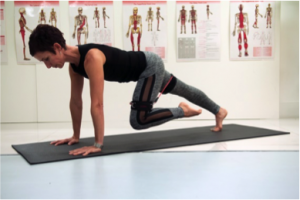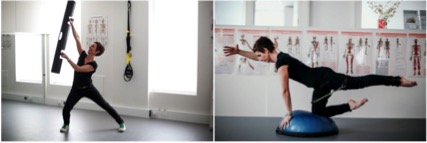
Keeping in Shape In-Between Jobs
What kind of exercises should I be doing when not dancing?
by Sally Harrison, Perfect Form Physiotherapy
I recently saw a patient in clinic who had developed shin pain. She was a professional dancer that was in-between jobs and looking to stay fit and in-shape. She had started running and had pain in both her lower legs after about 2-3km. So I questioned… why running?
The answer from her was … “I need to stay fit in between jobs and I don’t know what else to do.”
It can be hard to keep in-shape in-between jobs. We may not have much time to train outside of working more than one job and trying to get to class. We may not have enough money for a regular gym membership.
So, what exercises should we do?
When looking at what to do we want to think about:
- Ground based exercises: – as dancers we move our bodies around in relationship to the floor. We want our training to look the same, so exercises where we move our body mass about rather than moving something else (a machine) will reflect how the body needs to move and thus give us more ‘realistic’ strength. Push ups, squats, lunges, animal flow, yoga and other body weight exercises are great examples.
- Normal functional movements relevant to dance: – we want to be looking at good form with squats/lunges twisting/pushing/dynamic planks. We want to add variation to these movements. Don’t just squat with the feet hip width – try wide, narrow, turned in, turned out, offset… quick, slow, sustained tempo… and the list continues.

- Use large muscles groups and compound exercises which will use more energy, have more complexity and make you work harder. Combine squats with over head press, lunge with pull and twist, burpees with a push up, single leg squat with bicep curl, etc.
- Bare foot: – the foot is very rich with information for the body, a large number of proprioceptors feed vital information back to the brain as to where the body is in space and what it is doing. Shoes can hinder the ability of the foot to move freely, they’re not called ‘coffins for the feet’ for no reason!
 Cardio Vascular work: – CV work can easily be done with skipping, stair drills, jump drills and short hill runs. As dancing is predominantly short bursts of energy this needs to be how we train. A 10km run may be useful for steady-state aerobic work but short bursts of work, Tabata style, will mimic more closely the energy systems required for dance. Repetitive bouncing motions such as skipping are also great to build more tensile strength into our connective tissue (e.g strong achilles tendon).
Cardio Vascular work: – CV work can easily be done with skipping, stair drills, jump drills and short hill runs. As dancing is predominantly short bursts of energy this needs to be how we train. A 10km run may be useful for steady-state aerobic work but short bursts of work, Tabata style, will mimic more closely the energy systems required for dance. Repetitive bouncing motions such as skipping are also great to build more tensile strength into our connective tissue (e.g strong achilles tendon).- We can easily add load with resistance bands which is probably the most portable, cheap and effective type of external load. Load can be added to the lower and upper limbs for a complete dynamic movement programme. Load can be progressed with different strength bands. Using the band also trains eccentric load and deceleration. This part of movement is where most injuries occur, so working like this will help with injury prevention.
Creating a home/mobile gym doesn’t need to be expensive or difficult. You can get our own kit for home that can be portable and taken with you on your next job.
A training kit should have:
- Massage ball: (tennis ball will do) – to release certain areas of the body before training.
- Resistance tubing: at least 2 different strengths to add load to the body. A tether point can be useful (rail/door handle) but not necessary, you can just use your own body to anchor the band.
Extra kit if space and money allows:
- Small foam roller: more varied release techniques

- A weight: adjustable dumb bells or sand bell to provide consistent resistance
- Floor mat
- Suspension trainer: amazing full body training system that can be anchored to your bedroom door or taken outside.
- Large Swiss ball: large but gives good balance and stability training
(NB. There are some insanely cheap options for training kits from K Mart!)

This is an example of a circuit that could easily be done at home, in the park, or at the studio:
- Mobility session– full body opening; thinking of multi-planar components and specific releases using the ball
- Large compound movements – squats/lunges and vary what the feet do so that the body has more of a challenge (band under feet for added resistance)
- Skipping for 2 minutes
- Push ups
- Standing Row with the band (vary from wide and narrow) – tethered to something or under feet as a bent over row
- Jumping jacks and or tuck jumps for 1 min
- Plank to dog flow with knee drivers
- Squat and overhead press with band
- Plyo jump lunges x20
- Animal flow variations with forward and side kicks
- Pendular with bicep curls
***



















